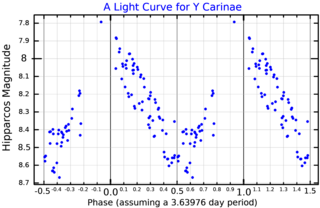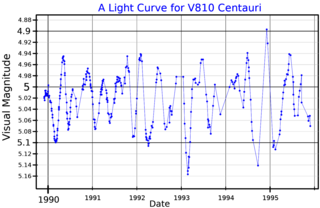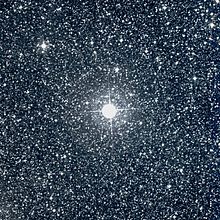
W Sagittarii is a multiple star system star in the constellation Sagittarius, and a Cepheid variable star.

X Sagittarii is a variable star and candidate binary star system in the southern constellation of Sagittarius, near the western constellation boundary with Ophiuchus. It has a yellow-white hue and is visible to the naked eye with an apparent visual magnitude that fluctuates around 4.54. The star is located at a distance of approximately 950 light years from the Sun based on parallax, and is drifting closer with a radial velocity of −10 km/s. The star has an absolute magnitude of around −2.85.

V399 Carinae is a variable star in the constellation Carina.

HD 84810, also known as l Carinae, is a star in the southern constellation of Carina. Its apparent magnitude varies from about 3.4 to 4.1, making it readily visible to the naked eye and one of the brightest members of Carina. Based upon parallax measurements, it is approximately 1,600 light-years from Earth.

V533 Carinae is a A-type supergiant and a Alpha Cygni variable star with a mean apparent magnitude of +4.59 in the constellation Carina. It is located at a distance of about 13,000 light years.

HD 96919, also known by its Bayer designation of z2 Carinae and the variable star designation of V371 Carinae, is a blue supergiant star in the constellation Carina. It lies near the Carina Nebula and at a comparable distance.

Omicron1 Centauri is a star in the constellation Centaurus. It is approximately 10,000 light years from Earth.

A yellow hypergiant (YHG) is a massive star with an extended atmosphere, a spectral class from A to K, and, starting with an initial mass of about 20–60 solar masses, has lost as much as half that mass. They are amongst the most visually luminous stars, with absolute magnitude (MV) around −9, but also one of the rarest, with just 20 known in the Milky Way and six of those in just a single cluster. They are sometimes referred to as cool hypergiants in comparison with O- and B-type stars, and sometimes as warm hypergiants in comparison with red supergiants.

Y Carinae is a Classical Cepheid variable, a type of variable star, in the constellation Carina. Its apparent magnitude varies from 7.53 to 8.48.

V810 Centauri is a double star consisting of a yellow hypergiant primary and blue giant secondary. It is a small amplitude variable star, entirely due to the supergiant primary which is visually over three magnitudes brighter than the secondary. It is the MK spectral standard for class G0 0-Ia.

V636 Scorpii is a multiple star system in the constellation Scorpius, 3,000 light years away. The primary is a Classical Cepheid variable and its visual magnitude varies from 6.4 to 6.9.

6 Cassiopeiae is a white hypergiant in the constellation Cassiopeia, and a small-amplitude variable star.

HD 33579 is a white/yellow hypergiant and one of the brightest stars in the Large Magellanic Cloud (LMC). It is a suspected variable star.

Sigma Ophiuchi, Latinized from σ Ophiuchi, is a single, orange-hued star in the equatorial constellation Ophiuchus. Its apparent visual magnitude is 4.31, which is bright enough to be faintly visible to the naked eye. The annual parallax shift of 3.62 mas as seen from Earth provides a distance estimate of roughly 900 light years. It is moving closer to the Sun with a radial velocity of −28 km/s.

S Muscae is a classical (δ) Cepheid variable star in the constellation Musca about 2,600 light years away.

9 Persei is a single variable star in the northern constellation Perseus, located around 4,300 light years away from the Sun. It has the Bayer designation i Persei; 9 Persei is the Flamsteed designation. This body is visible to the naked eye as a faint, white-hued star with an apparent visual magnitude of about 5.2. It is moving closer to the Sun with a heliocentric radial velocity of −15.2 km/s. The star is a member of the Perseus OB1 association of co-moving stars.

10 Persei is a blue supergiant star in the constellation Perseus. Its apparent magnitude is 6.26 although it is slightly variable.

V915 Scorpii is an orange hypergiant variable star in the constellation Scorpius.

BO Carinae, also known as HD 93420, is an irregular variable star in the constellation Carina.

HD 62058, is a variable star in the constellation Puppis. It is a rare yellow hypergiant and a candidate member of the open cluster NGC 2439. It is also an MK spectral standard for the class G2 0-Ia.

















